Albi is located in a bend of the river Le Tam about 70 km northeast of Toulouse. We visited the huge Gothic brick church there and were very impressed.
The 13th century, the great century of Albi's history
Albi already existed in early historical times as an inhabited rocky outcrop between the Tarn and one of its tributaries. The Romans established a town here called Civitas Albiensium. But it was not until the establishment of a bishopric in the 4th century that the city gained in importance. The oldest quarters develop around the centres of power: the cathedral and the bishop's palace. With the construction of the Pont-vieux in the 11th century, the city takes its rise as a trading centre and is surrounded by a city wall from the 12th century. In the 13th century, the south of France is afflicted by the religious schism of the Cathars. Bernard of Clairvaux is sent to Albi to calm tempers. But the inhabitants of the town give him a less than friendly reception, earning them their reputation as heretics. Throughout Europe, the Cathars are called Albigensians. And the campaign led by Simon de Monfort against them from 1208 to 1229 goes down in history as the Albigensian Crusade. Through it all, Albi remains faithful to the Church and joins the Crusaders. Thus the city comes through this period unscathed. As a result of the crusade, the bishops, who now had power over the city in their hands, had the fortress-like Palais de la Berbie built, as well as a fortress-like cathedral, two symbols of their power and their victory against the Cathar heresy.
The Renaissance, golden age of the woad
From the 15th century onwards, Albi flourished thanks to the trade in saffron and especially woad, a plant (pastel in Occitan) used to make a blue tincture. Thus the city comes to new wealth, which leads to a new expansion and the construction of beautiful Renaissance palaces.
In the 18th century, Albi took on a new face
The 18th century is marked by urban renewal: the city wall is smoothed, the Quai Choisel is laid out and the city is generally beautified. An engineer named Mariès, Haussmann's predecessor, drafted a development plan that was implemented in the second half of the 19th century. At this time, the Place du Vigan becomes a social hub with a prefecture, theatre, post office and cafés.
Industrial Age and Modernity
In the 19th and 20th centuries, Albi entered a period of industrialisation (flour milling, soup noodle production, metalworking, millinery). The Société des Mines d'Albi, which mined and processed coal at Cagnac-Carmaux, and the cooperative glassworks, founded in 1895 by striking glassmakers with the support of Jean Jaurès. Jaurès, mark this period. With these assets in hand, Albi was able to break new ground.
In 2010, the ensemble of the Bishop's Quarter was inscribed on the Unesco World Heritage List. Today, Albi has about 50,000 inhabitants.
Source: Brochure of the city of Albi
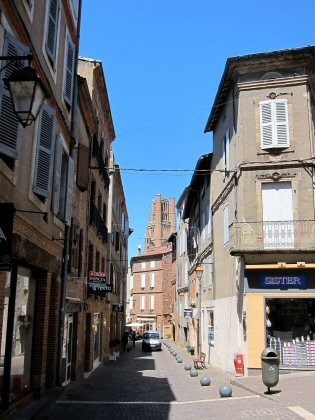
On the way to the cathedral
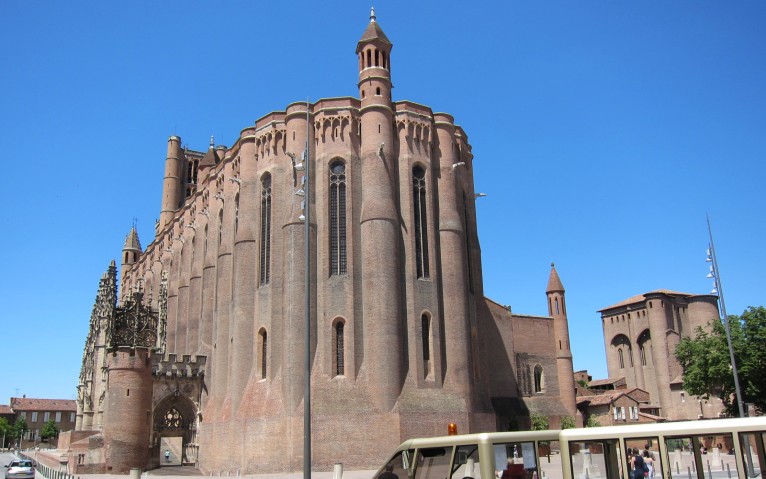
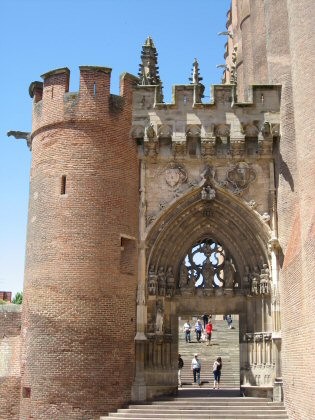
Sainte-Cécile Cathedral (13th - 16th c.)
Sainte-Cécile is the largest brick cathedral in the world. The building was commissioned by Bishop Bernard de Castanet and became one of the masterpieces of the southern Gothic style.
It is a symbol of the power of the church, created against the heresy of the Cathars.
The interior of the church is entirely painted, an extraordinary setting that dates back to the Renaissance bishops Louis I and Louis II of Amboise.
From the outside, the crenellated entrance gate with its tower looks like a fortress.
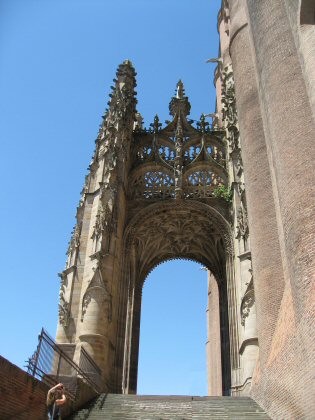
Climbing the stairs, you come to a fantastic, giant Gothic portal.


The church tower could also be the keep of a castle.
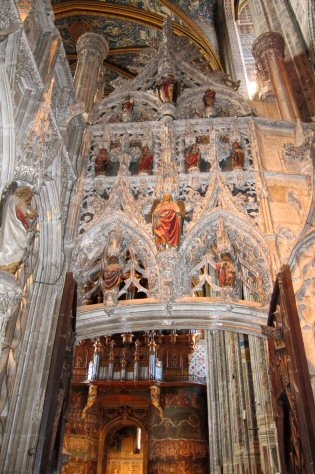
Inside you can't help but be amazed.
View of the giant painting of the Last Judgement, above it the 18th century organ.
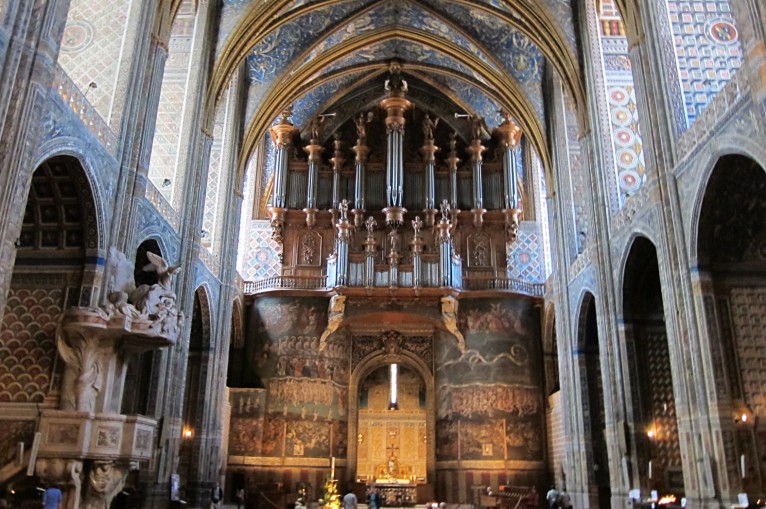
This work by organ builder Christophe Moucherel is as famous for the precious decoration of its casing as for its sound.
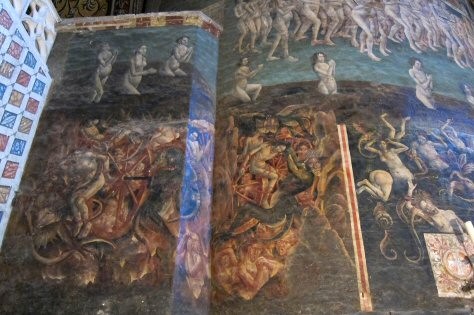
The Last Judgement (1474-1484): The largest medieval depiction of the Last Judgement is related in style to Flemish painting from this period.
The painting shows three areas: Heaven, Earth and Hell, where the damned expiate their guilt corresponding to the seven deadly sins.
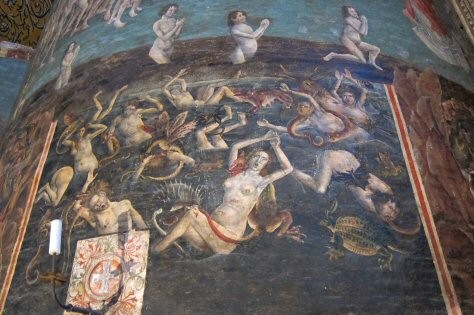
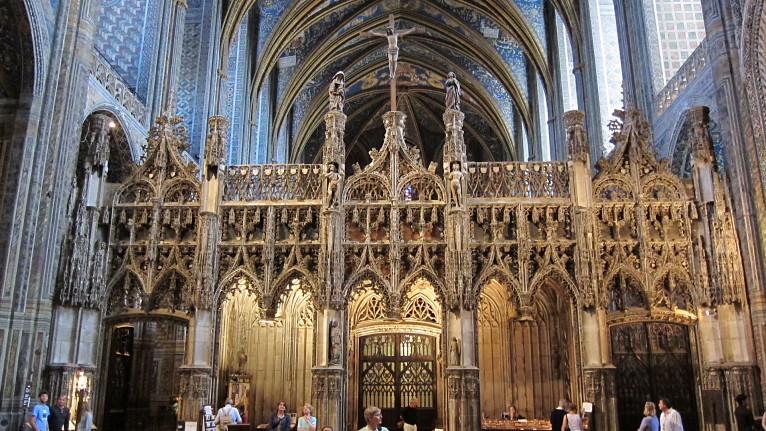
The rood screen and choir screen (1477-1484): In this important ensemble in the Flamboyant style, stone sculpture of astonishing quality and abundance unfolds. This includes numerous multi-coloured statues and countless chiselled motifs that look like lace made of stone.

The vaulted frescoes (1509 - 1512): scenes from the Old and New Testaments are depicted against an azure blue background amid foliage, putti and other typical Renaissance motifs. All this forms the largest ensemble of Italian painting in France.

Historian Jean Roques says of his city: "An administrative and service city that followed the developments of its time without losing its soul."